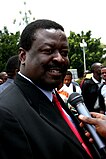Kenya Senate elections, 2013
|
|
|||||||||||||||||||||||||||||||||||||||||||||||||||
|
|||||||||||||||||||||||||||||||||||||||||||||||||||
|
|||||||||||||||||||||||||||||||||||||||||||||||||||
|
|||||||||||||||||||||||||||||||||||||||||||||||||||
General elections were held in Kenya on 4 March 2013. Voters elected the President, members of the National Assembly and new Senate, as well as County Governors and Representatives. They were the first elections held under the new constitution, which was approved in a 2010 referendum, and were also the first run by the new Independent Electoral and Boundaries Commission (IEBC).
The presidential elections were effectively a contest between Uhuru Kenyatta of the National Alliance (TNA) and Raila Odinga of the Orange Democratic Movement (ODM), with incumbent President Mwai Kibaki having served two terms and not being eligible for re-election. Kenyatta was backed by the Jubilee Alliance, whilst Odinga was supported by the Coalition for Reforms and Democracy (CORD). Kenyatta was declared the winner with 50.5% of the vote, meaning a second round of voting was not needed. Odinga unsuccessfully contested the results in the Supreme Court.
The elections were originally scheduled for 14 August 2012 or December 2012 were planned for the election, depending on a court ruling to be issued. The court ruled that presidential and parliamentary elections should be held in March 2013. This resulted in the resignation of several civil servants who wished to enter politics, as required by the Elections Act. On 28 December 2012, the Independent Electoral and Boundaries Commission announced the Notice of General Elections which confirmed polling day as 4 March. The nomination deadlines were set over a period between 29 January and 1 February, with presidential candidates submitting their nomination papers on 29 and 30 January.
...
Wikipedia



